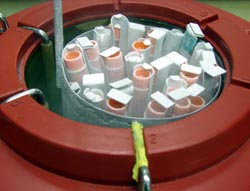Improving cryopreservation protocols
As attempts are carried out for the routine cryopreservation of European plant germplasm as a means of conservation, a number of obstacles have to be tackled. The EC-funded CRYMCEPT project focused on removing the obstacles as a means to pave the way for the wide application of cryopreservation in plant conservation. Cryopreserving European plant germplasm could in fact be one of the few ways to preserve endangered species for posterity. Project partners set out to define the optimum set of parameters linked to cryopreservation success, in other words minimum tissue damage. Scotland-based, University of Abertay in Dundee studied the extent of oxidative stress and used the knowledge for the development of improved protocols. Oxidative stress monitoring allows researchers identify those specific steps or components that cause cellular injury and make the required modifications. The resulting information can prove extremely useful to researchers and biotechnology companies involved in cryopreservation as well as all those interested in plant conservation studies. Improved protocols for cryopreservation are likely to impact tissue storage efforts in general, including animal tissue as well as plant material.







